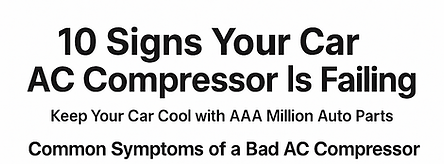How to Fix or Replace a Bad Car AC Compressor
(DIY + Pro Tips)
If your car’s AC compressor has stopped working, is making noise, or isn’t cooling properly, it’s important to address the issue quickly. A failing compressor can lead to poor air conditioning performance, refrigerant leaks, and even damage to the rest of your vehicle’s AC system. Whether you’re a DIY enthusiast or planning a professional repair, here’s everything you need to know.
1
Disconnect the Battery
Always start by disconnecting the negative battery terminal to prevent electrical shocks or shorts.
2
Recover the Refrigerant
Use a refrigerant recovery machine to safely remove all refrigerant from the system before disassembly. (This is required by law in most areas.)
3
Remove the Drive Belt and Components
-
Loosen the serpentine belt tensioner and remove the belt from the compressor pulley.
-
Remove any components or brackets blocking access to the compressor.
4
Disconnect the AC Compressor
-
Unplug the electrical connector and remove refrigerant lines connected to the compressor.
-
Be cautious — residual refrigerant may still be present.
5
Remove the Old Compressor
-
Unbolt the compressor from the engine block and carefully remove it from the vehicle.
6
Prepare and Install the New Compressor
-
Add the correct amount of refrigerant oil to the new compressor (check manufacturer specs).
-
Replace O-rings and seals to prevent future leaks.
-
Mount the new compressor, reconnect lines, and tighten bolts securely.
8
Vacuum and Recharge the System
-
Use a vacuum pump and manifold gauge set to remove air and moisture from the system.
-
Recharge with the correct type and amount of automotive refrigerant.
9
Reconnect Battery and Test the AC
-
Reconnect the battery, start the engine, and turn on the AC.
-
Check for cold air, unusual noises, and proper clutch engagement.
Pro Tips for Long-Lasting AC Performance
-
Run your AC regularly, even in winter, to keep seals lubricated and prevent leaks.
-
Replace the cabin air filter regularly to reduce system strain.
-
Check refrigerant levels annually and top off as needed.
-
Inspect the AC compressor clutch and pulley for wear before failure occurs.
When to Call a Professional
While many DIY mechanics can replace an AC compressor with the right tools, some situations are best left to a certified technician:
-
You don’t have access to refrigerant recovery or vacuum equipment
-
Electrical issues are causing compressor failure
-
There’s significant contamination in the system requiring a full AC flush
Professional car AC repair services can also detect deeper problems, such as failing condenser fans, faulty pressure switches, or leaking evaporators, that could damage your new compressor.




